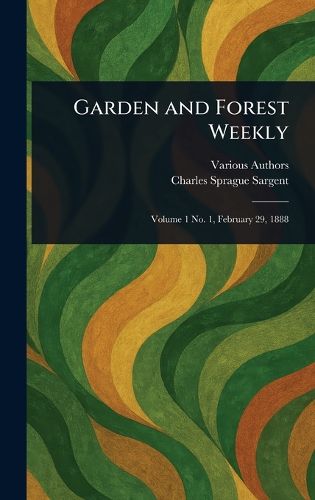Readings Newsletter
Become a Readings Member to make your shopping experience even easier.
Sign in or sign up for free!
You’re not far away from qualifying for FREE standard shipping within Australia
You’ve qualified for FREE standard shipping within Australia
The cart is loading…






This title is printed to order. This book may have been self-published. If so, we cannot guarantee the quality of the content. In the main most books will have gone through the editing process however some may not. We therefore suggest that you be aware of this before ordering this book. If in doubt check either the author or publisher’s details as we are unable to accept any returns unless they are faulty. Please contact us if you have any questions.
Discover the roots of American forestry and landscape design with the inaugural issue of "Garden and Forest Weekly," originally published February 29, 1888. This meticulously reproduced edition offers a fascinating glimpse into late 19th-century perspectives on horticulture, gardening, and environmental conservation.
Explore articles and observations concerning the vital role of forests and forestry, alongside discussions of practical gardening techniques and emerging ideas in landscape architecture. A valuable resource for anyone interested in the history of environmentalism and applied sciences, this periodical showcases the era's dedication to cultivating both natural beauty and sustainable practices.
Whether you're a student of horticulture, a landscape architect, or simply an individual passionate about plants, flowers, and protecting the environment, this historical document provides a unique window into the past and a foundation for understanding contemporary issues.
This work has been selected by scholars as being culturally important, and is part of the knowledge base of civilization as we know it.
This work is in the public domain in the United States of America, and possibly other nations. Within the United States, you may freely copy and distribute this work, as no entity (individual or corporate) has a copyright on the body of the work.
Scholars believe, and we concur, that this work is important enough to be preserved, reproduced, and made generally available to the public. We appreciate your support of the preservation process, and thank you for being an important part of keeping this knowledge alive and relevant.
$9.00 standard shipping within Australia
FREE standard shipping within Australia for orders over $100.00
Express & International shipping calculated at checkout
This title is printed to order. This book may have been self-published. If so, we cannot guarantee the quality of the content. In the main most books will have gone through the editing process however some may not. We therefore suggest that you be aware of this before ordering this book. If in doubt check either the author or publisher’s details as we are unable to accept any returns unless they are faulty. Please contact us if you have any questions.
Discover the roots of American forestry and landscape design with the inaugural issue of "Garden and Forest Weekly," originally published February 29, 1888. This meticulously reproduced edition offers a fascinating glimpse into late 19th-century perspectives on horticulture, gardening, and environmental conservation.
Explore articles and observations concerning the vital role of forests and forestry, alongside discussions of practical gardening techniques and emerging ideas in landscape architecture. A valuable resource for anyone interested in the history of environmentalism and applied sciences, this periodical showcases the era's dedication to cultivating both natural beauty and sustainable practices.
Whether you're a student of horticulture, a landscape architect, or simply an individual passionate about plants, flowers, and protecting the environment, this historical document provides a unique window into the past and a foundation for understanding contemporary issues.
This work has been selected by scholars as being culturally important, and is part of the knowledge base of civilization as we know it.
This work is in the public domain in the United States of America, and possibly other nations. Within the United States, you may freely copy and distribute this work, as no entity (individual or corporate) has a copyright on the body of the work.
Scholars believe, and we concur, that this work is important enough to be preserved, reproduced, and made generally available to the public. We appreciate your support of the preservation process, and thank you for being an important part of keeping this knowledge alive and relevant.